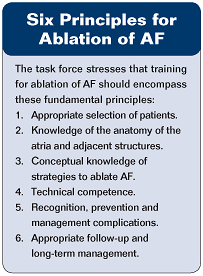Guidelines established on use of ablation for AF
Consider ablation in patients with AF whose symptoms interfere with their quality of life.
The first international clinical consensus statement had been released regarding the use of catheter and surgical ablation techniques to treat atrial fibrillation.
The Expert Consensus Statement on Catheter and Surgical Ablation of Atrial Fibrillation aims to improve patient care by providing physicians with a state-of-the-art review of catheter and surgical ablation for AF. Study data have shown that only one quarter of patients with AF receive appropriate care.
“These guidelines are a major step toward helping physicians provide better, safer and more consistent care for heart patients worldwide,” said Hugh Calkins, MD, chair of the Heart Rhythm Society’s scientific and clinical guidelines committee and director of the arrhythmia service and electrophysiology laboratory at The Johns Hopkins Hospital.
Foundation of guidelines
Convened by the HRS, a task force of international heart rhythm specialists representing the American College of Cardiology, the American Heart Association, the European Heart Rhythm Association, the European Cardiac Arrhythmia Society, the Society of Thoracic Surgeons and the HRS has developed guidelines to provide a foundation of current knowledge for medical personnel involved with catheter and surgical ablation of AF. The statement addresses the indications, techniques, training and follow-up for patients undergoing these procedures.

According to the Expert Consensus Statement, ablation for AF should be considered in patients with AF whose symptoms are severe enough to interfere with their quality of life and who have failed or been intolerant to treatment with at least one antiarrhythmic medication.
Ablation of AF is more difficult, is associated with greater risks and requires more careful follow-up than other ablation procedures. Therefore, the task force stresses that training for ablation of AF should encompass six fundamental principles:
1. Appropriate selection of patients.
2. Knowledge of the anatomy of the atria and adjacent
structures.
3. Conceptual knowledge of strategies to ablate AF.
4. Technical competence.
5. Recognition, prevention and management complications.
6. Appropriate follow-up and long-term management.
“There has been a lot of hype about ablation for atrial fibrillation, and this set of guidelines tells us that the field is now approaching a degree of maturity so that cardiovascular practitioners can begin to understand who is a good candidate and what to expect from the procedure in the right hands,” said Dan Roden, MD, director of the division of clinical pharmacology at Vanderbilt University School of Medicine and member of the Cardiology Today Editorial Board.
He said that one important aspect of the guidelines is the clear statement of eligibility and a specific statement that this type of ablation is different from others in approach, success rates and complication rates. – by Tara Grassia.
For more information:
- Calkins H, Brugada J, Packer DL, et al. HRS/EHRA/ECAS expert consensus statement on catheter and surgical ablation of atrial fibrillation: Recommendations for personnel, policy, procedures and follow-up. Heart Rhythm [online]. 2007;doi:10.1016/j.hrthm.2007.04.005.
